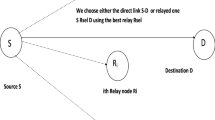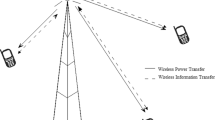Abstract
In this paper, we suggest two adaptive cooperation protocols for millimeter wave communications. The first protocol chooses, between non cooperative and cooperative communications, the protocol that offers the highest instantaneous throughput. The second protocol chooses, between non cooperative and cooperative communications, the protocol maximizing the average throughput. Both protocols use adaptive modulation and coding to select the best modulation and coding scheme maximizing the average or instantaneous throughput. Our results are valid for interference limited millimeter wave communications in the presence of Nakagami fading channels.







Similar content being viewed by others
References
Zöchmann, E.; Groll, H.; Pratschner S.: A small-scale fading model for overtaking vehicles in a millimeter wave communication link. In: 2019 IEEE 20th International Workshop on Signal Processing Advances in Wireless Communications (SPAWC) (2019)
Jihao, L.; Zhenfeng, Y.; Yibing, L.; Xiaohang, S; Ji, L.; Wei, Z.: Research on millimeter wave phased array antenna for 5G communication. 2019 IEEE 2nd International Conference on Electronic Information and Communication Technology (ICEICT)
Tsai, C.-H.; Pepe, F.; Mangraviti, G.; Zong, Z.; Craninckx, J.; Wambacq, P.: A 22.5–27.7-GHz fast-lock bang-bang digital PLL in 28-nm CMOS for millimeter-wave communication With 220-fs RMS Jitter. IEEE Solid State Circuits Lett. 2(9), 232–239 (2019)
Pan, P.; Zi, Z.; Cai, J.; Feng, J.: Millimeter Wave Vacuum Electronic Amplifiers for High Data Rate Communication. In: 2019 44th International Conference on Infrared, Millimeter, and Terahertz Waves (IRMMW-THz) (2019)
Kaur, J.; Singh, M.L.: User assisted cooperative relaying in beamspace massive MIMO NOMA based systems for millimeter wave communications. China Commun. 16(6), 103–113 (2019)
Fukatsu, R.; Sakaguchi, K.: Millimeter-Wave V2V communications with cooperative perception for automated driving. In: 2019 IEEE 89th Vehicular Technology Conference (VTC2019-Spring)
Zhang, J.; Huang, Y.; Xiao, M.; Wang, J.; Yang, L.: Energy-efficient cooperative hybrid precoding for millimeter-wave communication networks. In: 2018 IEEE Global Communications Conference (GLOBECOM)
Zhang, J.; Huang, Y.; Zhang, C.; He, S.; Xiao, M.; Yang, L.: Cooperative multi-subarray beam training in millimeter wave communication systems. In: GLOBECOM 2017—2017 IEEE Global Communications Conference
Zhu, R.; Wang, Y.E.; Xu, Q.; Liu, Y.; Li, Y. D.: Millimeter-wave to microwave MIMO relays (M4R) for 5G building penetration communications. In: IEEE Radio Wireless Symposium (RWS) (2018)
Jagyasi, D.; Ubaidulla, P.: Low-complexity two-way AF relay design for millimeter wave communication systems. In: 2017 IEEE 85th Vehicular Technology Conference (VTC Spring)
Abdelreheem, A.; Omer, O.A.; Esmaiel, H.; Mohamed, U.S.: Deep learning-based relay selection in D2D millimeter wave communications. In: 2019 International Conference on Computer and Information Sciences (ICCIS)
Ma, B.; Shah-Mansouri, H.; Wong, V.W.S.: Full-duplex relaying for D2D communication in millimeter wave-based 5G networks. IEEE Trans. Wirel. Commun. 17(7), 4417–4431 (2018)
Lee, J.; Lee, Y.H.: AF relaying for millimeter wave communication systems with hybrid RF/baseband MIMO processing. In: 2014 IEEE International Conference on Communications (ICC)
Sim, G.H.; Asadi, A.; Loch, A.; Hollick, M.; Widmer, J.: Opp-relay: managing directionality and mobility issues of millimeter-wave via D2D communication. In: 2017 9th International Conference on Communication Systems and Networks (COMSNETS)
Kong, L.; Ye, L.; Wu, F.; Tao, M.; Chen, G.; Vasilakos, A.V.: Autonomous relay for millimeter-wave wireless communications. IEEE J. Sel. Areas Commun. 35(9), 2127–2136 (2017)
Fan, B.; Tian, H.; Zhu, S.; Chen, Y.; Zhu, X.: Traffic-aware relay vehicle selection in millimeter-wave vehicle-to-vehicle communication. IEEE Wirel. Commun. Lett. 8(2), 400–403 (2019)
Ntontin, K.; Verikoukis, C.: Relay-aided outdoor-to-indoor communication in millimeter-wave cellular networks. IEEE Syst. J. (2019). https://doi.org/10.1109/JSYST.2019.2939745
Abbas, H.; Hamdi, K.: Millimeter wave communications over relay networks. In: 2017 IEEE Wireless Communications and Networking Conference (WCNC)
Liu, J.-H.; Chao H.-L.: Joint relay selection and scheduling algorithm for inter-piconet communications in millimeter wave wireless personal area networks. In: 2011 IEEE 22nd International Symposium on Personal, Indoor and Mobile Radio Communications (PIMRC)
Akoum, S.; El Ayach, O.; Heath, R.W.: Coverage and capacity in mmWave cellular systems. In: 2012 Conference Record of the Forty Sixth Asilomar Conference on Signals, Systems and Computers (ASILOMAR) (2012)
Bai, T.; Alkhateeb, A.; Heath, R.W.: Coverage and capacity of millimeter-wave cellular networks. IEEE Commun. Mag. 52(9), 70–77 (2014)
Sun, S.; Rappaport, T.S.; Heath, R.W.; Nix, A.; Rangan, S.: Mimo for millimeter-wave wireless communications: beamforming, spatial multiplexing, or both? IEEE Commun. Mag. 52(12), 110–121 (2014)
Ghasemi, A.; Sousa, E.S.: Fundamental limits of spectrum-sharing in fading environments. IEEE Trans. Wirel. Commun. 6(2), 649–658 (2007)
Hasna, M.O.; Alouini, M.S.: Outage probability of multihop transmission over Nakagami fading channels. IEEE Commun. Lett. 7(5), 216–218 (2003)
Gradshteyn, I.S.; Ryzhik, I.M.: Table of Integrals, Series and Products, 5th edn. Academic, San Diego, CA (1994)
Proakis, J.: Digital Communications, 5th edn. Mac Graw-Hill, New York (2007)
Author information
Authors and Affiliations
Corresponding author
Appendix A
Appendix A
Let Y and Z be two independent Gamma r.v. with joint PDF expressed as [26]
Let \(U=\frac{Y}{Z}\) and \(V=Y+Z\), the determinant of Jacobian matrix is equal to
We have \(Z=\frac{V}{1+U}\) and \(Y=\frac{UV}{1+U}\). We deduce the PDF of (U, V) as
The PDF of U is computed as
We have [25]
Using (45) and (46), we obtain
The PDF of SNR at the destination given in (6) can be deduced from (47) by setting : \(m_1=m_{SD}\), \(m_2=P_Da_{D}\), \(\frac{\beta _1}{m_1}=\beta _{SD}\) and \(\frac{\beta _2}{m_2}=b_{D}\).
Rights and permissions
About this article
Cite this article
Halima, N.B., Boujemâa, H. Adaptive Cooperation for Millimeter Wave Communications. Arab J Sci Eng 45, 6389–6397 (2020). https://doi.org/10.1007/s13369-020-04488-5
Received:
Accepted:
Published:
Issue Date:
DOI: https://doi.org/10.1007/s13369-020-04488-5




